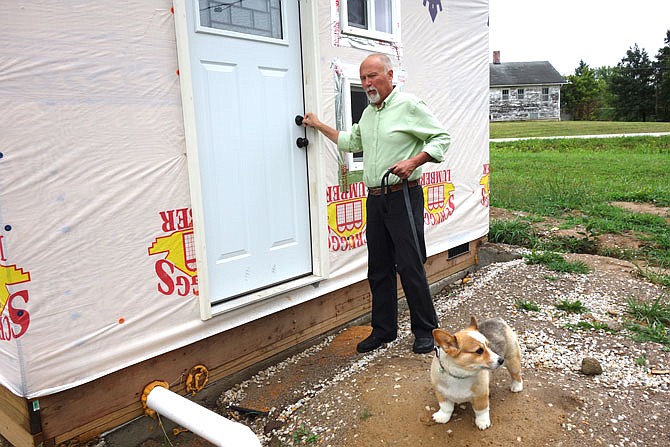Before anyone had even heard of tiny houses, Stephen Gilpin knew he wanted to live in one.
"I've always gravitated towards small living spaces," Gilpin said. "When I graduated in 1979 people said it couldn't be done."
But in 2017, tiny houses are increasingly popular, and Gilpin is finally building one of his own in Fulton. While he operates the High Handsome clothing store in Jefferson City, his future is growing at the corner of Glenstone Drive and South U.S. Business 54.
The building's frame and roof are more or less complete. With his corgi Cooper in tow, Gilpin pointed out where his oven and microwave will go, the place he'll mount his television, the loft that'll easily hold his queen-sized bed and the way all the pieces will fit together in the small space.
"For a tiny house really to be a tiny house, it's got to be cute," he said. "The landscaping too - cute, cute, cute."
He plans to hang flower boxes under his windows and put in a circle drive.
"I believe it's the first tiny house in mid-Missouri," Gilpin said.
It's certainly the first his builder, Greg Rich, has ever constructed. A general contractor from Holts Summit, he met Gilpin through a friend.
"The last house I built was 4,000 square feet, so it's quite a change," Rich said.
Challenges
Gilpin said at first, he had trouble getting contractors to bid on the project because the typical method of estimating cost per square foot didn't work. Once construction got underway, the project wasn't too different from the usual, Rich said.
"It's really not much different from other houses," he said. "We're building it to code."
Rich said some people are able to dodge building code requirements - such as minimum square footage - by building their tiny house on wheels, so it's classified as an RV or mobile home.
A 2015 survey by the American Tiny House Association found 63 percent of tiny house owners had their homes on wheels. More than half - 58 percent - of owners said they were "living tiny" illegally or in a legal gray area.
However, Gilpin likes having a foundation beneath him, and he and Rich said they've found Fulton city officials easy to work with. Planning and Protective Services Director Les Hudson has been particularly helpful.
"To my understanding, there was not any restriction on how large or small a house in Fulton could be until I came on the scene five years ago," Gilpin said. "In the interim, the city has decided that houses must have at least 125 square feet of open living space."
His 14-by-13-foot floor plan, plus the bedroom loft, totals 268 finished square feet - easily exceeding the minimum.
"As long as it met the international building code size-wise I'm fine with it," Hudson said. "We welcome him to town."
He said there are several lots in town he thinks would be perfect for a tiny house.
Gilpin's major challenge has been financing.
"Banks don't finance tiny houses," he said. "They kind of see them as sheds."
While high-end tiny houses can cost as much as a modest regular house, Gilpin expects his to cost $19,000 -$20,000. That includes the two lots of land he purchased. He's had to pay largely in cash, he said, which has been especially challenging as a business owner.
This has slowed down construction somewhat, but Rich said the project could be completed, start to finish, within three months.
The appeal
America's houses have been growing for decades.
In 1977, the median size of a new single-family house was 1,610 square feet, according to United States Census Bureau data. In 2016, it was 2,422 square feet.
And for people like Gilpin, that's too much space.
While no clear data is available on the number of tiny homes in the U.S., there's plenty of evidence people are interested. On television, there are shows like "Tiny House, Big Living," "Tiny House Nation," "Tiny House Builders" and others. A Google search for "tiny house movement" turns up half a million results. Amazon has more than 1,000 tiny house-related books for sale.
"(Rich) has six people lined up who want him to build a tiny house for them," Gilpin said.
The appeal varies depending on the individual, he added. For many, it's financial.
"You can live mortgage-free," he said.
He estimates his utility bill will only be around $50 a month.
Some people enjoy the minimalist lifestyle. Others like how easy the houses are to customize.
"They're kind of meant to be however you design 'em," Gilpin said.
Gilpin added he's been approached by people who work in senior housing who think tiny houses could provide the elderly a way to live more independently, with less upkeep to worry about.
As for Gilpin, he plans on living in his tiny house for the rest of his life. If he gets too infirm to climb the ladder to the loft, he has room for a twin bed downstairs.
"This is my toe-tag house," he said.

